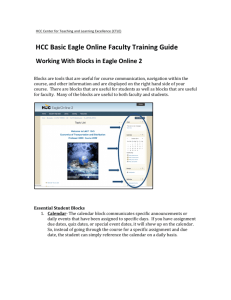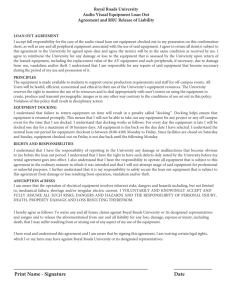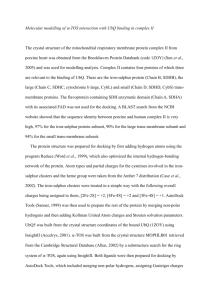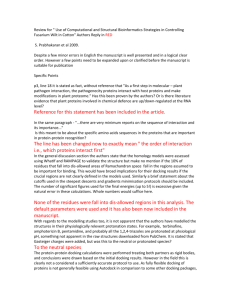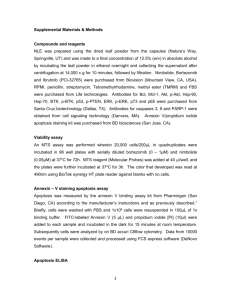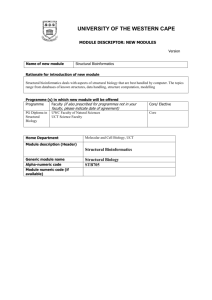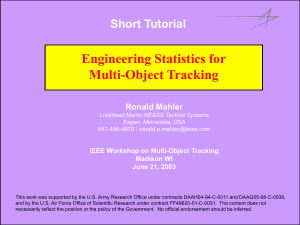novel paradigms for drug discovery shotgun
advertisement
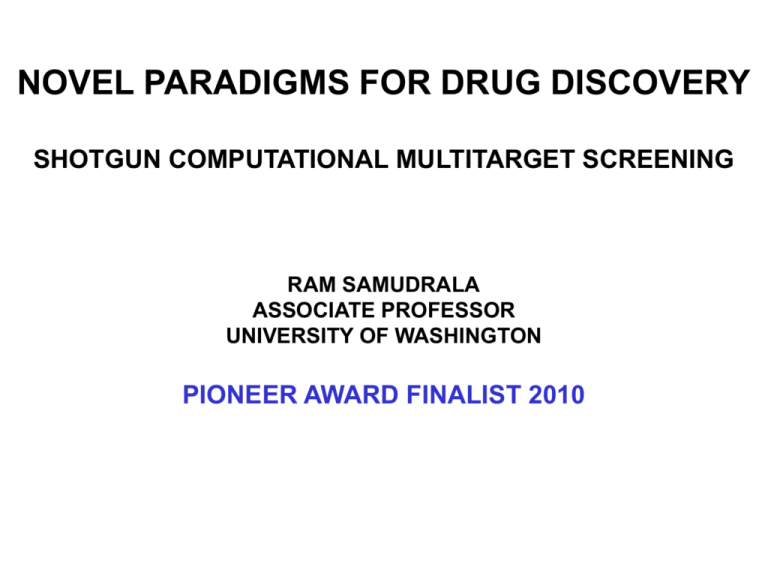
NOVEL PARADIGMS FOR DRUG DISCOVERY SHOTGUN COMPUTATIONAL MULTITARGET SCREENING RAM SAMUDRALA ASSOCIATE PROFESSOR UNIVERSITY OF WASHINGTON PIONEER AWARD FINALIST 2010 SHOTGUN MULTITARGET DOCKING WITH DYNAMICS ALL KNOWN DRUGS FRAGMENT BASED (~5,000 FROM FDA) DOCKING WITH DYNAMICS (~50,000,000) PRIORITISED HITS DISSOCIATION CONSTANTS (KD) (~300-500) + ALL TARGETS WITH KNOWN STRUCTURE (~5,000-10,000) MACHINE LEARNING IN VITRO STUDIES herpes, malaria, dengue hepatitis C, dental caries HIV, HBRV, XMRV M Lagunoff (UW), W Van Woorhis (UW), S Michael (FCGU), J Mittler/J Mullins (UW), G Wong/A Mason/L Tyrell (U Alberta), W Chantratita/P Palittapongarnpim (Thailand) CLINICAL STUDIES/APPLICATION INITIAL CLINICAL TRIALS IN VIVO STUDIES PROSPECTIVE PRELIMINARY VERIFICATION Predicted protease (dimer) + inhibitor: HERPES DENGUE (HSV, CMV, KSHV) Viral E protein Observed: Function is inactivated. Prediction #1 Prediction #2 KD protease ligand ≤ μM KD protease dimer ≤ μM Herpes viral load Experiment 1 Experiment 2 2/4 ≤ µM ED50 against dengue virus PLoS Neglected Tropical Diseases, 2010. 14 targets MALARIA Multitarget protocol: 2,344 → 16 → 6 ≤ 1 µM ED50 HTS protocol: 2,687 → 19 ≤ 1 µM ED50 HTS protocol: 2,160 → 36 ≤ 1 µM ED50 Docking protocol: 355,000 → 100 → 1 ≤ 10 µM ED50 Docking protocol: 241,000 → 84 → 4 ≤ 10 µM ED50 Trends in Pharmacological Sciences, 2010. SHOTGUN MULTITARGET DOCKING WITH DYNAMICS ALL KNOWN DRUGS FRAGMENT BASED (~5,000 FROM FDA) DOCKING WITH DYNAMICS (~50,000,000) PRIORITISED HITS DISSOCIATION CONSTANTS (KD) (~300-500) + ALL TARGETS WITH KNOWN STRUCTURE (~5,000-10,000) MACHINE LEARNING herpes, malaria, dengue HIV, HBRV, XMRV hepatitis C, dental caries M Lagunoff (UW), W Van Woorhis (UW), S Michael (FCGU), J Mittler/J Mullins (UW), G Wong/A Mason/L Tyrell (U Alberta), W Chantratita/P Palittapongarnpim (Thailand) CLINICAL STUDIES/APPLICATION Docking with dynamics Fragment based Multitargeting Use of existing drugs Drug/target maching learning matrix PK/ADME/bioavailability/toxicity/etc. Biophysics + knowledge iteration Fast track to clinic (paradigm shift) Cocktails/NCEs/optimisation Translative: atomic → clinic DISCOVER NOVEL OFFLABEL USES OF MAJOR THERAPEUTIC VALUE HERPESVIRUS PROTEASE DRUG OPPORTUNITY All these three viruses cause life-threatening diseases in immunocompromised patients. HSV drugs alone represent a > $2 billion dollar yearly market and growing at a 10% rate. Nearly 90 million people worldwide are infected with the genital herpes virus, and about 25 million of them suffer frequent outbreaks of painful blisters and sores. CMV is a major cause of mortality in transplant patients, and drugs against it represent a $300 million dollar yearly market. Acylovir and related drugs are all nucleoside analogues/inhibitors whose patents will soon expire. Our protease inhibitor is a novel type of anti-herpes agent that may be used in combination therapy. The inhibitor has been evaluated in mouse models of cancer and found to very nontoxic. Inhibitor can be modified. Topical applications are therefore possible with a high likelihood of success. PLATFORM OPPORTUNITY Partner with Biotech, Pharma to work on their libraries of compounds, targets, diseases (be a hired gun, share revenue). Apply platform a set of first world diseases with potential for large revenue, patent findings, and license the findings out. Platform may be applied as a separate company or as a SRA with UW (similar to Pioneer Award budget). Keep drug/target interaction matrix a trade secret. License new uses OR license modifications of those drugs OR both. Update above list as new drugs and new targets are identified, so a constant set of hits and leads will be available for patenting and licensing. ??? BUSINESS ACTIVITIES Have WA corporation: 3D Therapeutics, Inc. Nominal CEO: Jason North. Board currently includes Perry Fell (cofounder of Seattle Genetics) and Sonya Erickson (Cooley). Scientists include Michael Lagunoff, Wesley van Voorhis, Roger Bumgarner, and Ram Samudrala. License for first generation platform and hits/leads somewhat negotiated with the UW. Patents: •Michael SF, Isern S, Garry R, Costin J, Jenwithesuk E, Samudrala R. Optimized dengue virus entry inhibitory peptide (DN81). Priority/filing date: July 13, 2007. •Jenwitheesuk E, Lagunoff M, Van Voorhis W, Samudrala R. Compositions and methods for predicting inhibitors of protein targets. Priority/filing date: July 6, 2007. ADVANTAGES OF OUR APPROACHES Costs are reduced: Computational discovery Use of preapproved drugs Lower number of failed drugs Probabily of success is higher: Multitarget inhibition Mechanism of action is known Use of preapproved drugs Side effects may be predicted Correlation coefficient PROTEIN INHIBITOR DOCKING WITH DYNAMICS HIV protease 1.0 with MD 0.5 without MD ps 0 0.2 0.4 0.6 0.8 1.0 MD simulation time Jenwitheesuk ACCURACY COMPARISON Bernard & Samudrala. Proteins (2009). BACKGROUND AND MOTIVATION My research on protein and proteome structure, function, and interaction is directed to understanding how genomes specify phenotype and behaviour; my goal is to use this information to improve human health and quality of life. Protein functions and interactions are mediated by atomic three dimensional structure. We are applying all our structure prediction technologies to the area of small molecule therapeutic discovery. The goal is to create a comprehensive in silico drug discovery pipeline to increase the odds of initial preclinical hits and leads leading to significantly better outcomes downstream in the clinic. The knowledge-based drug discovery pipeline will adopt a shotgun approach that screens all known FDA approved drug and drug-like compounds against all known target proteins of known structure, simultaneously examining how a small molecule therapeutic interacts with targets, antitargets, metabolic pathways, to obtain a holistic picture of drug efficacy and side effects. Find new uses for existing drugs that can be used in the clinic, with a focus on third world and neglected diseases with poor or nonexisting treatments. MULTITARGET DOCKING WITH DYNAMICS NOVEL FRAGMENT BASED MULTITARGET SCREENING Disease & target identification TRADITIONAL SINGLE TARGET SCREENING COMPOUND SELECTION Multiple disease related proteins Compound database (~300,000) Single disease related protein Compound library DRUG-LIKE (~5000 from FDA) Computational docking with dynamics Initial candidates Experimental verification Success rate +++++ Time . Cost $ Computational docking Initial candidates Experimental verification Success rate ++ Time . Cost $$$ High throughput screen Experimental verification Success rate + Time . Cost $$$$$ INHIBITION OF ALL REPRESENTATIVE HERPES PROTEASES Predicted: Observed: Function is inactivated. protease ligand KD < μM protease dimer KD < μM Jenwitheesuk/Myszka INHIBITION OF ALL HERPESVIRUSES Viral load HSV KSHV CMV Fold inhibition Computationally predicted broad spectrum human herpesvirus protease inhibitors is effective in vitro against members from all three classes and is comparable or better than antiherpes drugs Our protease inhibitor acts synergistically with acyclovir (a nucleoside analogue that inhibits replication) and it is less likely to lead to resistant strains compared to acyclovir HSV Viral load HSV Experiment 1 Experiment 2 Experiment 3 Lagunoff MALARIA INHIBITOR DISCOVERY Predicted inhibitory constant 10-13 10-12 10-11 10-10 10-9 10-8 10-7 None Trends in Pharmacological Sciences, 2010. Jenwitheesuk/ Van Voorhis/Rivas/Chong/Weismann MALARIA INHIBITOR DISCOVERY +++++ COMPARISON OF APPROACHES $ Multitarget computational protocol 2,344 compounds High throughput protocol 1 2,687 compounds simulation 16 top predictions experiment 6 ED50 ≤ 1 μM High throughput protocol 2 2,160 compounds high high throughput throughput screen screen 19 ED50 ≤ 1 μM 36 ED50 ≤ 1 μM ++ $$$$$ Computational protocol 1 241,000 compounds simulation 84 top predictions In comparison to other approaches, including experimental high throughput screens, our multitarget docking with dynamics protocol combining theory and experiment is more efficient and accurate. experiment 4 ED50 ≤ 10 μM Computational protocol 1 355,000 compounds simulation 100 top predictions experiment 1 ED50 ≤ 10 μM Trends in Pharmacological Sciences, 2010. +++ $$$ Jenwitheesuk/Van Voorhis/Rivas DENGUE INHIBITOR DISCOVERY Prediction #1 Prediction #2 PLoS Neglected Tropical Diseases, 2010. Jenwitheesuk/Michael WHY WILL IT WORK Fragment based docking with dynamics: dynamics improves accuracy; fragmentation exploits redundancy in existing drugs; most accurate docking protocol out there. Use of existing drugs: exploits all the knowledge from Pharma. Multitargeting: multiple low Kd can work synergistically; screening for targets and antitargets simultaneously. Knowledge based: potential from known structures, will have a big matrix relating drugs, targets, PK, ADME, solubility, bioavailability, toxicity, etc.; rich dataset for combining our biophysics based methods with machine learning tools in an iterative manner. Known drugs Targets with known structure docking score, Kd, PK, ADME, absorption, bioavailability, toxicity BROADER IMPACT Multiple drugs can be combined to produce therapeutic effect and overcome disease resistance. Good for any condition where one or more viable targets exist. Harnesses the power of all the drug discovery done thusfar; new paradigm for fast track FDA approval Translational approach goes from providing atomic mechanistic detail to measuring clinical efficacy in one shot. Protocol can be used to design novel drugs also. SUITABILITY FOR THE PIONEER AWARD Not good for Pharma because of reuse of existing drugs (most profit in novel compounds) Not good for Pharma because of focus on third world/neglected diseases. Not good for Pharma because of nonfocus on single target model they love. Marked departure from my protein structure prediction work, but now applied research from basic protein folding to producing therapeutics in a clinic. Funding will help focus work on drug discovery which until now has been done on a shoestring. CONCLUSION High risk endeavour is successful if one or more diseases currently without an effective treatment can be treated completely.
